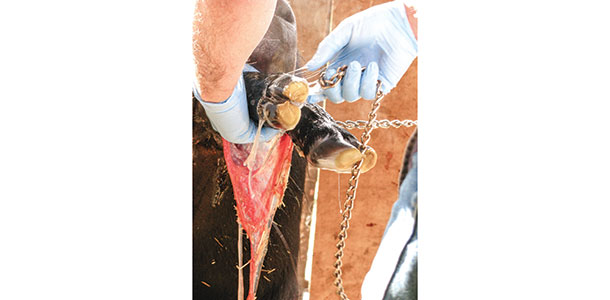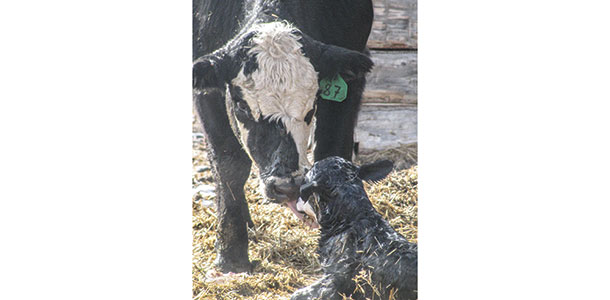The added risk of dystocia (due to malpresentation), retained placenta, higher abortion rates and the chance of freemartin heifers are just a few of the many things producers could encounter with multiple births.
It is important producers are prepared and understand pre-calving and post-calving management techniques to ensure each animal a healthy start. And if managed right, the pros of having multiple births could possibly outweigh the cons, especially with today’s high cattle prices.
Brian Kirkpatrick, a professor of animal science at the University of Wisconsin, says typically twin births are undesired by most beef producers because of the problems associated with the trait. But it doesn’t have to be that way, he says.
“Most often, multiple births or twins are not desired on a beef operation because they were unexpected or a big surprise,” Kirkpatrick says. “If producers knew which cows were going to have twins, the more prepared they would be, and then it probably wouldn’t be viewed as such a negative thing.”
Utilizing ultrasound technology
One way producers can incorporate good management is to use pregnancy diagnostics early on to determine single versus multiple pregnancies, he says. By detecting which cows are carrying multiple calves, producers can pay close attention to specific cows at calving and be ready to provide assistance when needed.
The most effective method to use is ultrasound technology. It can detect a multiple pregnancy as early as 30 days into gestation. But in order to get the most accurate readings, it is best to wait until the 45 to 60 days range to account for any gestation loss that can occur in the earlier stages of development.
Using ultrasound anywhere beyond 80 days, however, can become difficult to identify since the uterus drops over the pelvic rim, blocking the view of the fetuses.
The standard palpation method can also be used, but it doesn’t always give the most accurate results, he says. Only about 50 percent of twin pregnancies are identified through the palpation method.
“It is hard to beat ultrasound as the technique in determining whether a cow has a single or twin pregnancy. It is the most effective, least expensive way to do it,” Kirkpatrick says.
Shorter gestation length
Robert Cushman, a research physiologist and a contributor to the Nebraska Clay Center beef twinning project, says it is important to know approximately when a cow is going to calve. He points out that the gestation length for cows pregnant with twins is five to seven days shorter than a single pregnancy.
In most cases, the length of the cow’s postpartum interval to first estrus is increased if she gives birth to twins or multiples, and if she calves late, that is where the problem lies.
In a normal production cycle, the cows usually calve earlier and have a longer length of time before they are rebred. But when a cow is pregnant with twins and calves late, the chances she will cycle before the next breeding cycle are slim, he says.
And if she experiences any dystocia or retained placenta during calving on top of that, it limits her chances of getting rebred significantly.
“Because of the shorter gestation length, increased chance of dystocia and possible retained placenta, calving multiple calves can be very labor-intensive, especially right around calving. It is important producers have a basic knowledge about reproductive management and incorporate it into their management practices,” he says.
Cushman also suggests having a backup plan in case a cow can’t raise multiple calves. He points out that with the twinning project, they occasionally ran into instances where a first-calf heifer couldn’t raise more than one calf. They had to have a secondary plan in mind, which usually involved grafting a calf or calves to another cow if possible.

The risk of dystocia due to malpresentation
Another common problem that can occur with multiple calves is the higher incidence of malpresentations when calving, Kirkpatrick says. Since these calves are born at lighter weights than singles, dystocia (calving difficulty) due to an abnormally large calf is rare, but abnormal presentation in the birth canal is not. It is important that each calf has both feet forward and moves through the birth canal head-first.
Operations with high incidences of multiple births or those that select for high twinning rates should have proper calving facilities readily available, he says. A basic calving pen should include a headgate and a gate that doubles as a crowding gate. This type of calving pen can easily be constructed or is readily available for purchase, he says.
If the calves need to be repositioned, it is important it is done quickly but carefully, Kirkpatrick says. The calves should be easier to pull, but producers should be careful not to tear the umbilical cord since it is their only source of oxygen at this point.
“The more you anticipate calving, and the more you are prepared with things like calving pens, the easier it is to calve multiple births,” Kirkpatrick says. “From my experience, and from a number of other people, it is much easier to deal with a cow with twins than a cow that is giving birth to an abnormally large calf any day.”
Other key considerations
Michael Lamb, a cow-calf producer in western Kentucky, says his operation has had a few sets of twins over the years but never triplets or quadruplets. He says one of the most important things to remember when a cow has twins is to make sure they both receive an adequate amount of colostrum.
Lamb says a lot of the time one calf will get up and nurse while the other will hang back. It is important producers keep a close eye on them and make sure they both receive their proper amount of colostrum, even if it requires bottle-feeding them, he says.
Lamb also suggests starting the calves on feed as soon as possible to make up for lower levels of milk and prepare them for the possibility of early weaning. Since calves can be weaned as early as 60 days, early weaning could be a possible method to let the cow recover and rebreed sooner rather than later.
The cow’s health should also be evaluated and watched at this point, he says. Producers should provide additional supplemental energy prior to the end of gestation and after calving. Not all cows are the same – some are better milkers, some are bigger, some are smaller – but the key is adapting and changing to fit the situation, he says.
“A lot of work and money go into raising twins. But at the same time, twins can be worth the trouble if you have the time and the willingness to put forth some extra effort,” Lamb says. “After all, it is two in one season.”
If producers use proper management before and after calving, multiple births can be a benefit to an operation, he says. It is important certain precautions are taken and the correct amount of care is given to both the calves as well as the cow. By doing all these things, producers could find that multiple births could be better than one. ![]()
Cassidy Woolsey is a freelance writer based in Utah.
PHOTOS
PHOTO 1: To avoid low milk supplies, twin calves should be placed on feed early and weaned early.
PHOTO 2: When calves are born producers should make sure that all calves receive the proper amount of colostrum.
PHOTO 3: Multiple births should be easier to pull than an abnormally large calf. Make sure all calves move through the birth canal head-first and both feet forward. Photos by Tayler Teichert.










